Food Stocks: Top Picks for 2024
The term ‘food stocks’ can be an ambiguous one; so we want to get specific. In this post, we’re focusing specifically on quick-serve restaurant brands globally, a sector where successful concepts like Starbucks, Chipotle, and McDonald’s have provided significant returns for investors. While the restaurant industry is challenging, with many failed ventures, successful ones stand out due to their solid unit economics, strong branding, scalability, and ability to manage inflationary pressures. Today, we’re highlighting a mix of quick-serve restaurant prospects: some new, some well-known, and others mature yet still offering promising investment opportunities.
Want analyst ratings, price alerts & valuation data on food stocks?
PRO TIP:
For a well-rounded food stock portfolio, focus on:
-
- Geographical Diversity: Choose companies from different regions. This diversification reduces risk and taps into various market dynamics.
- Cuisine Variety: Invest in businesses with diverse food offerings like sushi, Mexican, or tapas. This exposes you to multiple consumer trends and preferences.
- Lifecycle Stages: Include both emerging and established companies. Younger companies might offer growth potential, while established ones can provide stability.
- Growth Potential: Look for companies with plans to expand their store count. Effective management execution on these plans is crucial.
- Global Presence: Consider companies with international operations for broader market exposure.
*Data as of May 24th, 2024
As an investor, keeping track of the stock market is challenging due to its fast pace and data intensity. A well-crafted watchlist is crucial, enabling you to monitor stock performance, receive timely updates, and access detailed financial analytics at a glance.
Track Stock Performance: Get Analyst Ratings, Alerts, and Valuations
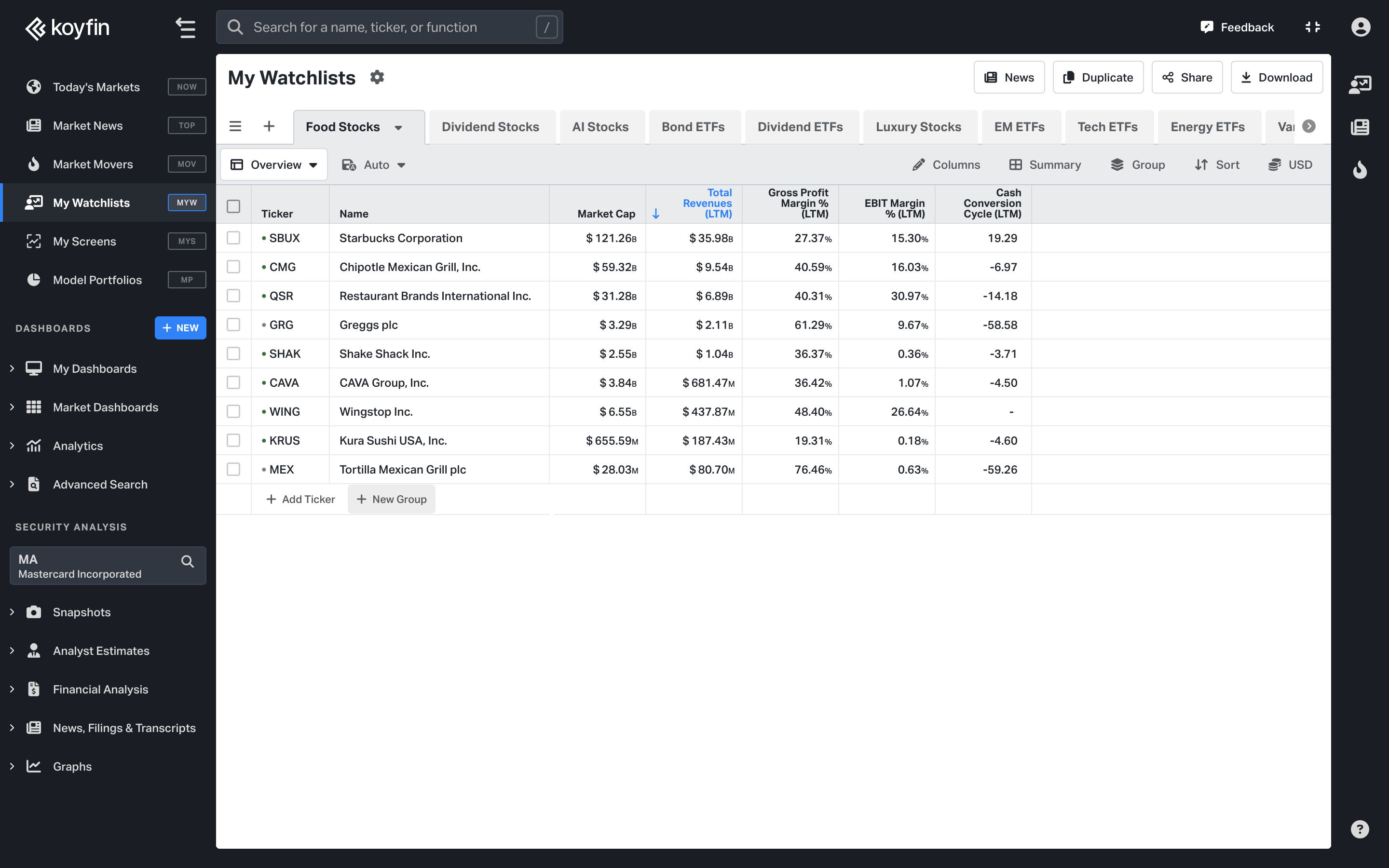
Starbucks (SBUX)
Starbucks is acknowledged with transforming coffee culture in the United States since it started back in the 1970s; and the later the world. Today, the coffee chain is home to more than 37,000 stores across North America (17,592 stores), China (6,480 stores), and the rest of the world (13,150 stores). Currently, 51% of Starbucks’ stores are company-operated, while the remaining 49% are franchised. During the pandemic, Starbucks suffered like most restaurants, but after North America’s fast recovery, international’s recovery a year later, and China now showing promising signs of recovery, Starbucks is stronger than ever. China, a market where Starbucks operates 100% of the stores itself, captures much of the attention these days, as it stands to be the company’s largest growth vector going forward. The company is eyeing 45,000 stores across the world in the coming years, most of which will come from China’s growth.
Across North America and China, Starbucks currently has 75 million Starbucks Rewards members in their system, a figure that grew 25% YoY. Starbucks is expected to report $36.79 billion in 2024 (+2.26%), $40.09 billion by 2025 (+8.97%) and $43.46 billion by 2026 (+8.41%).
Key Investment Insights for Starbucks (SBUX):
Focus:
Coffee
Market Cap:
$88.7 billion
Approx Store Count:
37,222
Revenue TTM:
$36.5 billion
Gross Margin:
27.7%
EBIT Margin:
15.3%
Cash Conversion Cycle:
17.6 days
Restaurant Brands International (QSR)
QSR represents some of the world’s most beloved brands like Popeyes (4,200 locations), Burger King (18,900 locations), Firehouse Subs (1,200 locations), and Tim Hortons (5,600 locations). Collectively, QSR controls over 30,000 locations throughout more than 125 markets across the world. Across their four brands, QSR generates revenue from a mixture of franchise royalties, property revenues, and consumer products. The company also pays the most generous dividend of our picks, at 3.5%.
The collective is one of the more mature companies on our list with more modest growth expectations. Nevertheless, the ‘land and expand’ strategy that QSR deploys for its brands across different countries does offer promising expansion opportunities for years to come. QSR is expected to report $8.53 billion in sales in 2024 (+21.42%), $9.58 billion in 2025 (+12.33%) and $9.85 billion by 2026 (+2.89%).
Key Investment Insights for Restaurant Brands International (QSR):
Focus:
Multibrand
Market Cap:
$30.3 billion
Approx Store Count:
30,000
Revenue TTM:
$7.2 billion
Gross Margin:39
.8%
EBIT Margin:
31.2%
Cash Conversion Cycle:
-12.5 days
Chipotle (CMG)
Chipotle is the daddy of the Mexican quick-serve movement; serving burritos, bowls, chips and guac for over 30 years. Since their IPO in 2006, shareholders have benefited from incredible returns of ~24% compounded annually. It’s uninspired, but while people are looking for the next Chipotle, it’s more likely the ‘next Chipotle’ is…. Chipotle itself. With 3,200 stores in the States, there are still decades of growth ahead and thousands of more Chipotles before their domestic market, and the fantastic unit economics they have there, becomes saturated. Management is eyeing more than 7,000 stores across the country and has recently begun to lay more focus on international expansion. In 2009, Chipotle’s former Chief Development Office stated they “don’t have a timeline for when [international] will be meaningful to the business”. By the beginning of 2015, they operated just 15 stores internationally. By 2018 it was just 37 and today they operate ~57; most of which are in Canada.
In recent earnings calls, there have been talks of accelerating Canadian growth, making more of an effort in Europe, and their recent partnership with Alshaya Group to franchise stores in the Middle East are promising signs. While international revenue won’t be material for years still, and the unit economics won’t translate as well given they are insistent on the company ownership model in Europe, its another lever the company can pull down the line. Those reinvestment opportunities provide investors with considerable optionality.
Chipotle is already a well-established brand, and because of their scale in their domestic territory, they already boast attractive, mature, margins. Gross margins of 40.9%, EBIT margins of 16.3%, and net income margins of 12.7% are industry-leading, and the company kicks off generous amounts of free cash flow too. While some feel Chipotle’s growth is saturated, we feel there are decades of room left to grow for this beloved brand. Chipotle is expected to report $11.35 billion in sales in 2024 (+15.02%), $12.88 billion in 2025 (+13.39%) and $14.68 billion by 2026 (+13.98%).
Key Investment Insights for Chipotle (CMG):
Focus:
Burritos, Bowls, and Guac
Market Cap:
$86.2 billion
Approx Store Count:
3,300
Revenue TTM:
$10.2 billion
Gross Margin:
40.9%
EBIT Margin:
16.3%
Cash Conversion Cycle:
-6.5 days
Greggs PLC (GRG)
Greggs PLC, located in the UK, is by far the most dominant force in baked goods across the country. Boasting more than 2,300 stores (of which ~440 are franchised) which sell their iconic sausage rolls and steak bakes, there is not a single competitor that comes closes to Greggs’ size. Having been in business since 1939, Greggs has since become interwoven with the culture of Britain. Their low-cost offering and considerable gross margins have allowed them to survive recessions relatively unscathed. Prior to Roger Whiteside’s appointment in 2013, Greggs was losing market share, like-for-like sales were stuttering, and the company’s portfolio (thanks to its history of small tuck-in M&A) felt like a collection of odd-lots.
Some stores would have in-house bakeries and produce their own goods, others would not. In 2014 the last in-store bakery would close after embarking on a multi-year journey that would establish a robust supply chain to streamline operations. Whiteside is credited with turning Greggs from a decentralized collection of bakeries into a well-oiled, centralized, machine. He has since left the business in charge of Roisin Currie, a senior executive of more than 10 years at Greggs.
The company has plans to expand beyond 3,000 in the next few years and is currently undergoing an aggressive CapEx expansion plan that is said to peak around 2025. Aside from store rollouts, Greggs has plans to capture additional revenues by expanding store opening hours into evening trade and embracing digital and delivery operations. Early signs have shown it to be a successful endeavor. The company currently boasts impressive gross margins of 60.7% and while it generates a considerable amount of operating cash flow, investors would do well to note that free cash flow has and will be suppressed for a few years until the reinvestment plans Greggs are undergoing a slowdown. Greggs is expected to report £2.02 billion in sales in 2024 (+11.36%), £2.21 billion in 2025 (+9.78%) and £2.42 billion by 2026 (+9.17%).
Key Investment Insights for Greggs PLC (GRG):
Focus:
Sausage Rolls & Steaks Bakes
Market Cap:
£2.9 billion
Approx Store Count:
2,300
Revenue TTM:
£1.8 billion
Gross Margin:
60.7%
EBIT Margin:
9.7%
Cash Conversion Cycle:
-21.7 days
Wingstop (WING)
You might think that chicken wings are old news, but Wingstop has managed to create a cult following and expand to more than 2,000 locations across the world and report 19 consecutive years of same-store sales growth with their iconic wings and sauce combo. The company even pays a dividend, one of the few on our list to do so. Wingstop started paying quarterly dividends towards the end of 2016 and has reported consecutive annual dividend increases ever since.
Similar to Chipotle, Wingstop offers industry-leading margins and kicks off attractive levels of free cash flow. On a trailing basis, gross margins are 48.6%, EBIT margins are 26.6%, and net income margins are 16.8%. Unlike Chipotle, however, Wingstop is heavily reliant on their franchising arm. Of the 1,794 stores located within the United States, 1,749 (97%) are franchises, with just 45 company-operated stores. Internationally, all 252 locations are franchised.
Wingstop is expected to report $585.27 million in sales in 2024 (+27.22%), $681.23 million in 2025 (+16.40%) and $788.78 million by 2026 (+15.79%).
Key Investment Insights for Wingstop (WING):
Focus:
Chicken Wings
Market Cap:
$11.2 billion
Approx Store Count:
2,046
Revenue TTM:
$497.1 million
Gross Margin:
48.6%
EBIT Margin:
26.6%
Cash Conversion Cycle:
-3.2 days
Shake Shack (SHAK)
Shake Shack started out life as a hotdog cart inside Madison Square Park in 2001 and later evolved into the brand it has become today; known for burgers, shakes, hotdogs, and sides. SHAK currently has 471 stores (which they call “Shacks”) worldwide. Of these, 43% are company-operated, and 57% are managed by their licensed partners; putting them on course to deliver their goal of 75 new Shacks in 2023. The burger joint’s gross margins have yet to recover since the pandemic, which stood in the mid-20% range prior to 2020. In the most recent year, margins improved for the second consecutive year to 17.4% and are expected to continue improving going forward, but are not expected to fully recover for years still. On the upside, SHAK is expected to return to profitability in 2023, after failing to report a positive EBIT or net income figure since 2019.
The company appears to be hoping that aggressive global expansion will give them the leverage to earn back their prepandemic margins and are expected to grow revenues at a fair clip in the coming years. Shake Shack is expected to report $1.25 billion in sales in 2024 (+14.94%), $1.44 billion in 2025 (+15.00%) and $1.63 billion by 2026 (+13.38%).
Key Investment Insights for Shake Shack (SHAK):
Focus:
Burgers and Shakes
Market Cap:
$4.1 billion
Approx Store Count:
471
Revenue TTM:
$1.1 billion
Gross Margin:
37%
EBIT Margin:1
.3%
Cash Conversion Cycle:
-0.9 days
Cava Group (CAVA)
Cava Group is the owner and operator of more than 279 Mediterranean tapas restaurants across the United States and recently completed their initial public offering in June 2023. They say that “IPO” stands for “Is Probably Overpriced” so we suggest exercising caution in the first few months of a newly public company’s existence on the stock market. While it may not be an attractive food stock to buy today, it could be one to keep on your watchlist and study while it settles into life as a public company.
Cava Group is expected to report $875.32 million in sales in 2024 (+20.12%), $1.04 billion in 2025 (+18.92%) and $1.24 billion by 2026 (+19.38%).
Key Investment Insights for Cava Group (CAVA):
Focus:
Mediterranean Tapas
Market Cap:
$8.9 billion
Approx Store Count:
279
Revenue TTM:
$728.7 million
Gross Margin:
37%
EBIT Margin:2
.1%
Cash Conversion Cycle:
-6.7 days
Tortilla Mexican Grill (MEX)
Tortilla Mexican Grill is, for all intents and purposes, a UK-only replica of Chipotle, with strong insider ownership from the CEO. They have some immaterial franchising operations overseas too. The current number of Chipotle stores in the UK stands at 16; a number which has barely moved since their entrance into the country back in 2010, and is largely confined to London. Tortilla, on the other hand, has grown from 5 to 76 stores over the same period, and now has the largest quick-serve Mexican business in the country by a wide margin. They also operated 8 franchised units in the Middle East.
The two closest competitors are Barburrito (with 17 locations) and Chipotle (with 16 locations). Barburrito was rescued from insolvency and is now owned by The Restaurant Group, where they are now a small fish in a big pond, and Chipotle has the resources to threaten Tortilla but has yet to demonstrate a willingness to. Tortilla shows promise of attractive unit economics but has yet to reach the scale to boast operating leverage. They are the most well-resourced business of their kind in the UK with superior margins and supply chain operations. This may even be an attractive acquisition target given the fact it trades at £27.5 million compared to its expected 2024 gross profit of £50 million. However, a word of caution. Tortilla Mexican Grill is by far the smallest food company on our list. Microcaps like Tortilla tend to be illiquid, more volatile, and less covered by Wall St analysts.
Tortilla is expected to report £72.67 million in sales in 2024 (+10.66%), £80.81 million in 2025 (+11.20%) and £89.37 million by 2026 (+10.59%).
Key Investment Insights for Tortilla Mexican Grill (MEX):
Focus:
Burritos, Bowls, and Guac
Market Cap:
£21.3 million
Approx Store Count:
84
Revenue TTM:
£65.7 million
Gross Margin:
77.3%
EBIT Margin:1
.7%
Cash Conversion Cycle:
-52.6 days
Kura Sushi (KRUS)
Kura Sushi USA is hoping that their family-friendly and novel conveyor belt sushi restaurants capture the attention of the American public; they recently surpassed a milestone of 50 stores across the country and believe they can climb to 300 in the next few years. KRUS is a US subsidiary of a Japanese parent company, Kura Sushi Inc., that has more than 450 locations across Japan. Thanks to their subsidiary status, Kura is able to tap their parent for liquidity when necessary. For instance, they borrowed money during the pandemic to pay for operations and repaid it a year later.
After a well-timed stock issuance earlier this year, the company now has a cash runway of 2-3 years which it can use to fund the CapEx required for its growth plans. Margins for Kura Sushi are slim currently, as they are scaling, but restaurant-level margins sit in the mid-20% range and average unit volumes (the average annual sales of a store after being open for 18 months) are ~$3.8 million and climbing. Costing Kura between $1.8 million and $2.2 million to build each store, the payback period is attractive.
The company recently upgraded its already popular rewards system, which has attracted more than 820,000 members, to a more modern and user-friendly UI, offering customers points which they can use during their next visit, as well as offers, promotions, and waitlists to see when stores are full. The latter upgrade will be well received by customers as Kura is both blessed and cursed with notoriously long wait times. In other attempts to reduce wait times and turnover speed, Kura Sushi has introduced tableside ordering and payment, as well as robotic servers. A word of caution, Kura’s float is lower than you’d expect on account of the parent company owning a vast majority of the outstanding shares. As such, the company has seldom traded at reasonable levels.
Kura Sushi is expected to report $246.03 million in sales in 2024 (+31.27%), $312.43 million in 2025 (+26.99%) and $388.60 million by 2026 (+24.38%). At present, all stores are company-operated.
Key Investment Insights for Kura Sushi (KRUS):
Focus:
Conveyor Belt Sushi
Market Cap:
$1.1 billion
Approx Store Count:
51
Revenue TTM:
$212.9 million
Gross Margin:
18.7%
EBIT Margin:-
0.5%
Cash Conversion Cycle:
-3.7 days
How To Find Top Food Stocks
Step 1: Sign Up to Koyfin for Free. Register an account and get started; no credit card required.
Step 2: Create a Screener. Head to ‘My Screens’, create a new screener and give it a name.
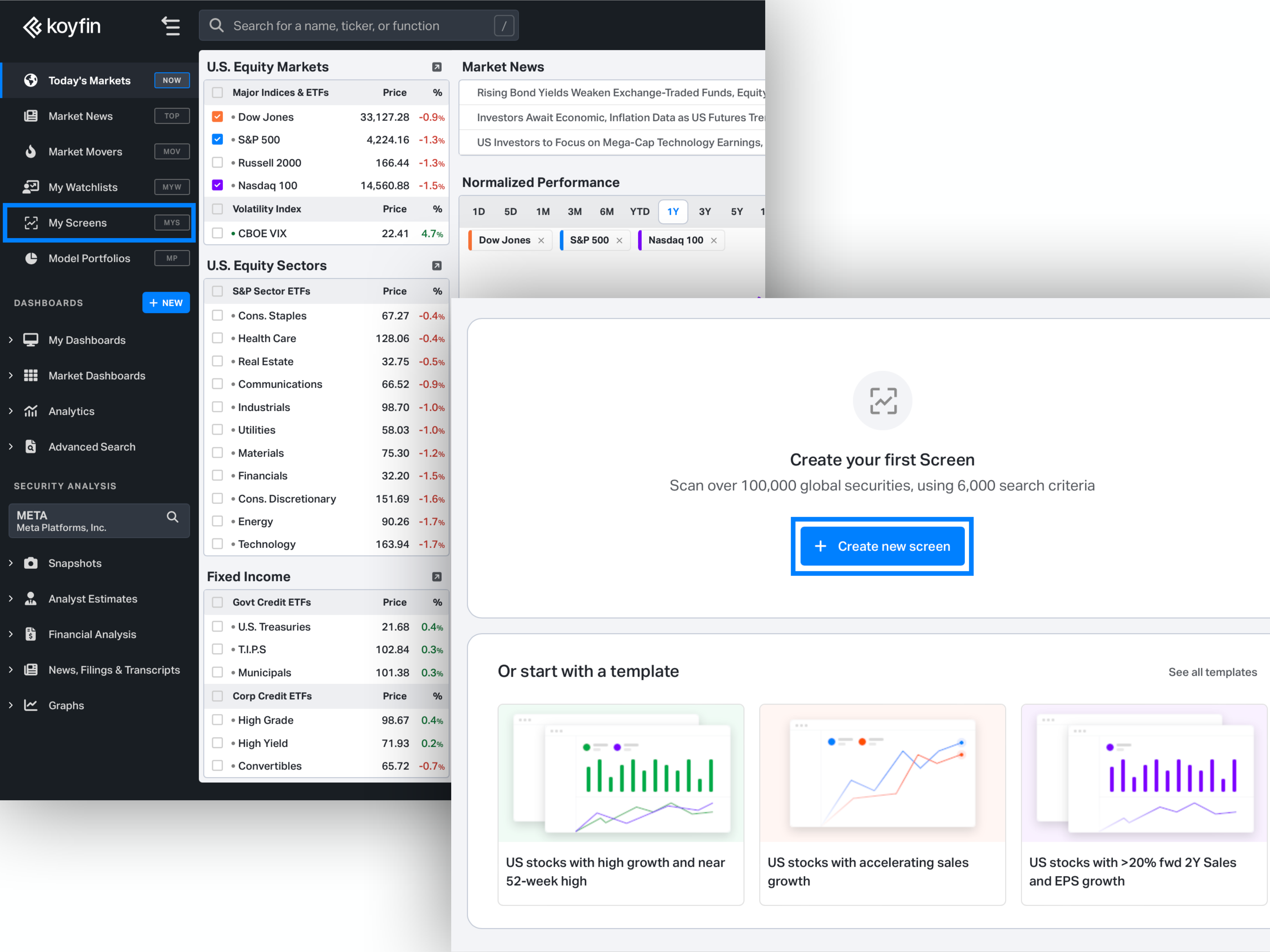
Step 3: Define your Investment Universe. Select a trading region, or multiple regions, and choose from a range of universe filters such as; country, ETF constituents, industry, sector, exchange, and description.
Add the industry for “Hotels, Restaurants and Leisure”.
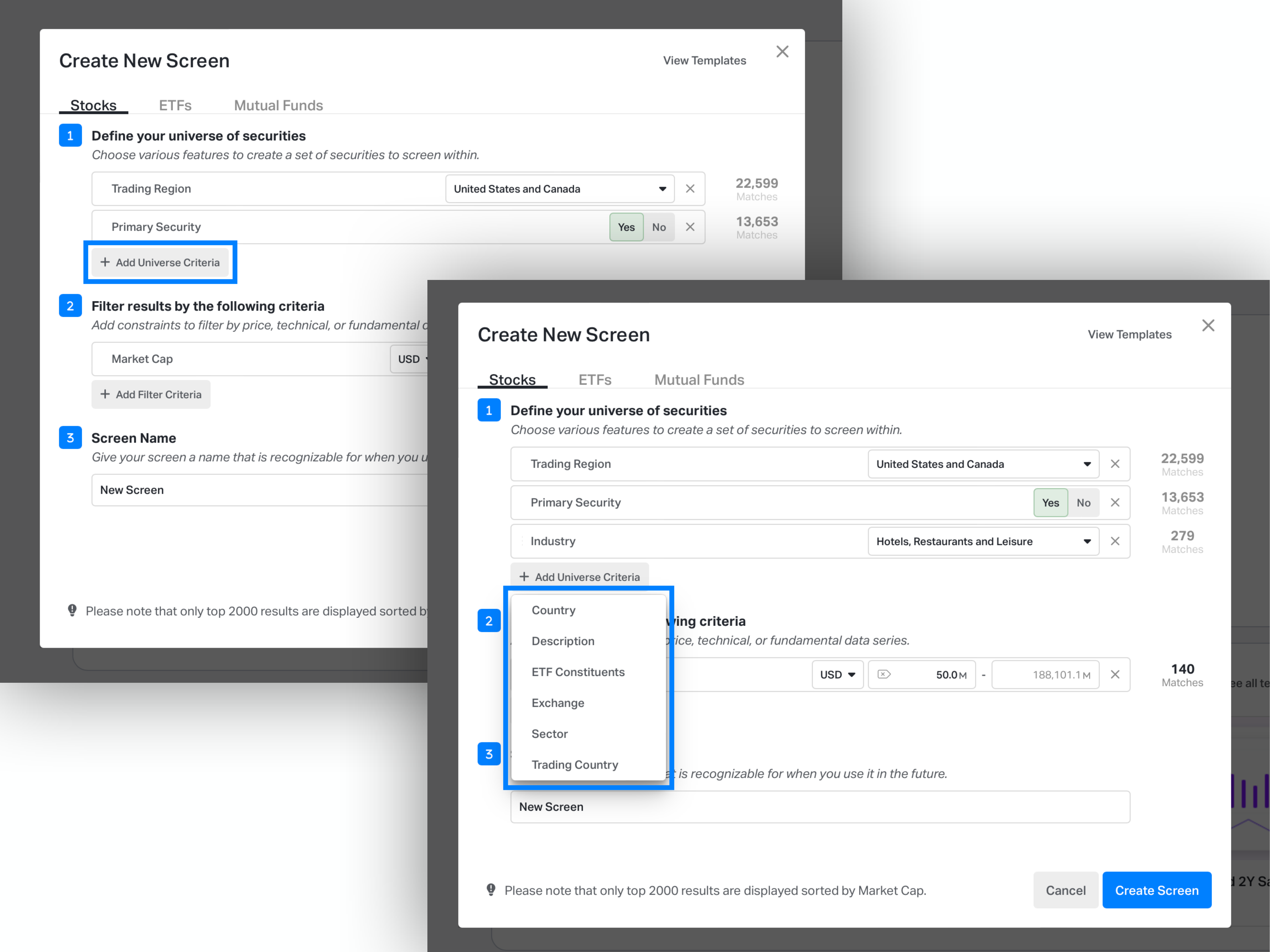
Step 4: Add Filter Criteria. We have thousands of data points you can add to a screener.
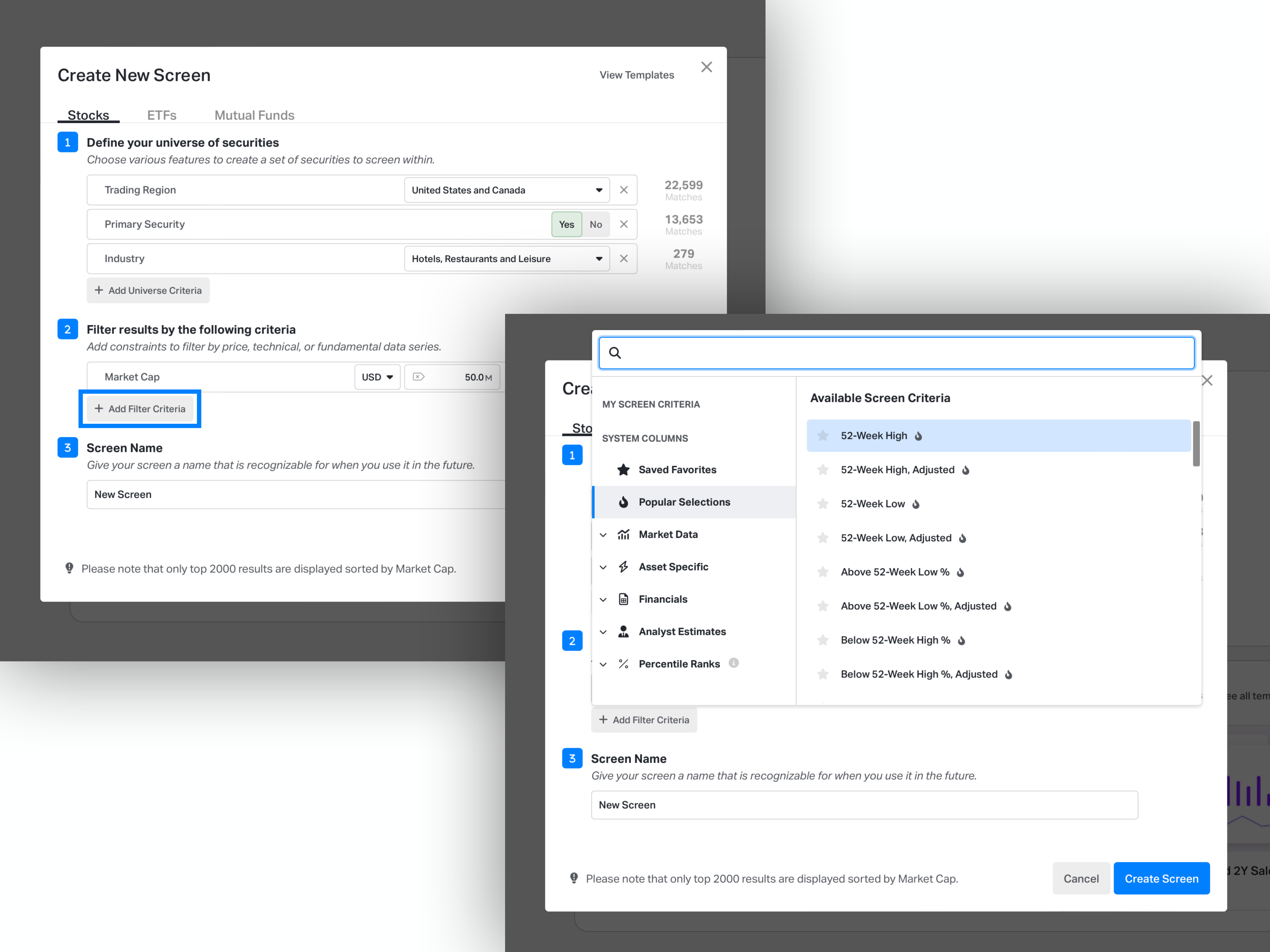
Step 5: Create Screen. When you are happy with your screener, give it a name, hit save and apply. You can also save this screener output as a watchlist too.
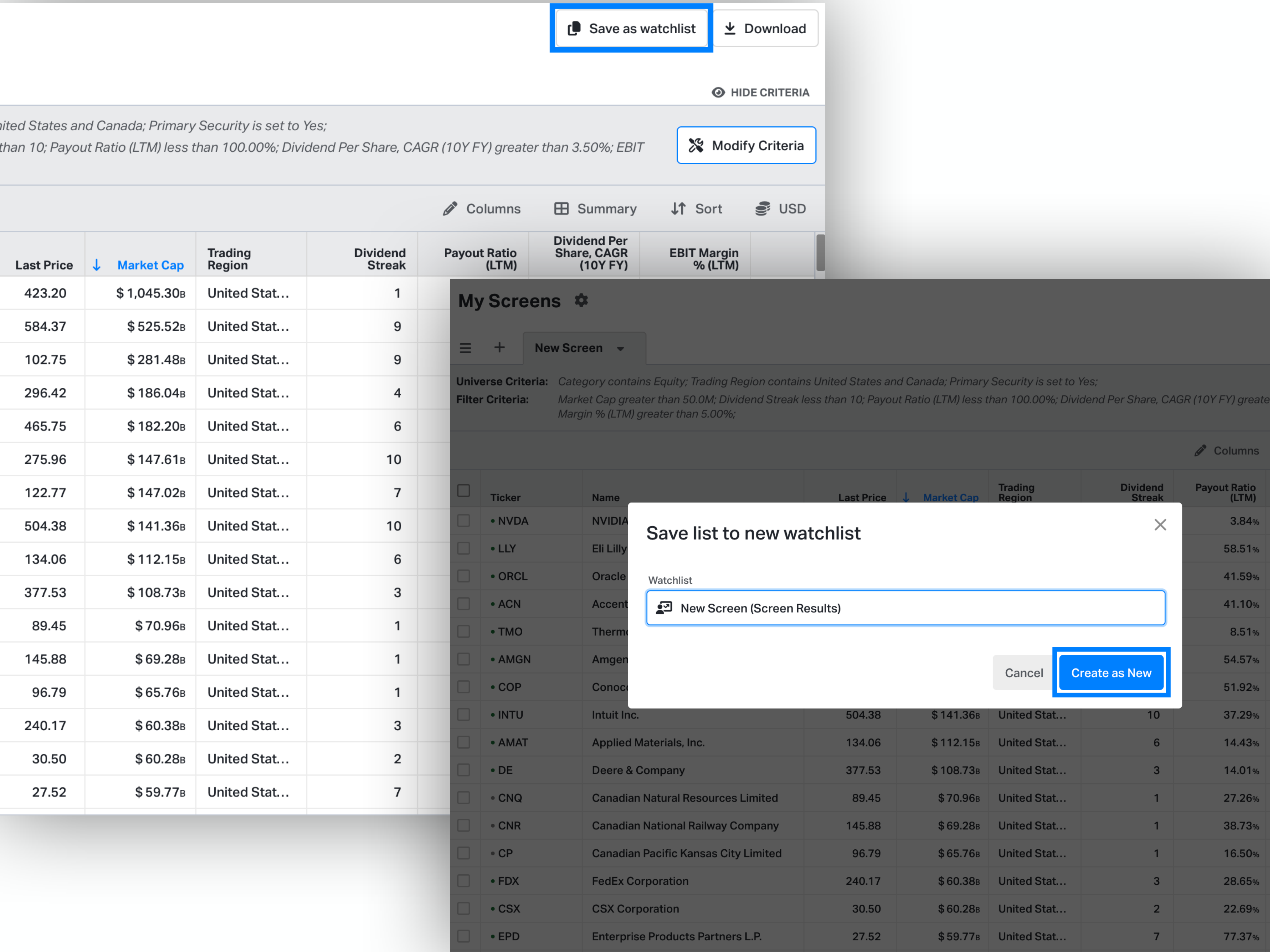
How to Create a Watchlist for Top Food Stocks
Step 1: Sign Up to Koyfin for Free. Register an account and get started; no credit card required.
Step 2: Create a Watchlist. Head to ‘My Watchlists’, create a new watchlist and give it a name.
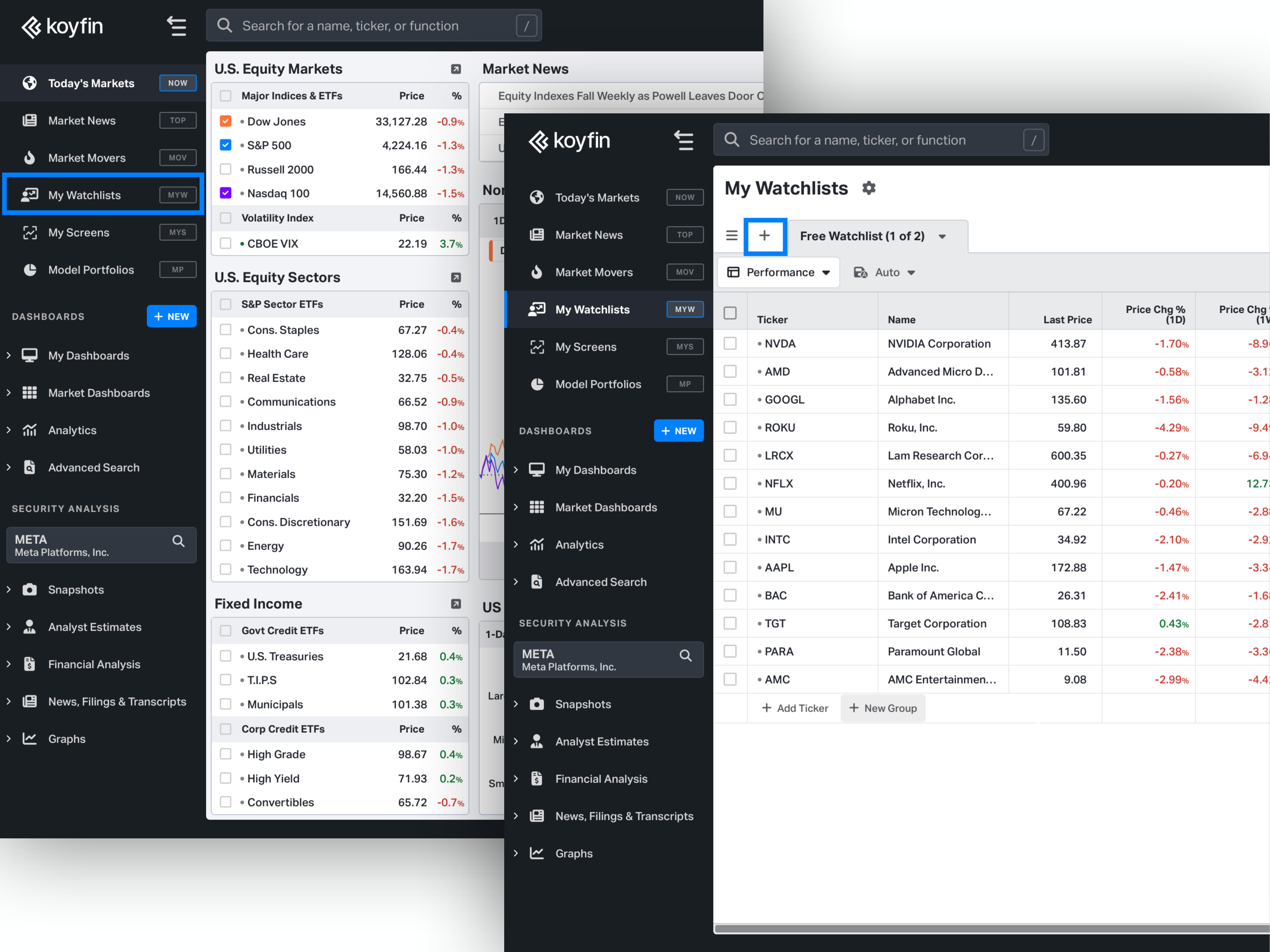
Step 3: Add Tickers. Click ‘Add Ticker’, then ‘Import Securities’, then copy and paste the below list of tickers.
SBUX, QSR, CMG, GRG, WING, SHAK, CAVA, MEX, KRUS
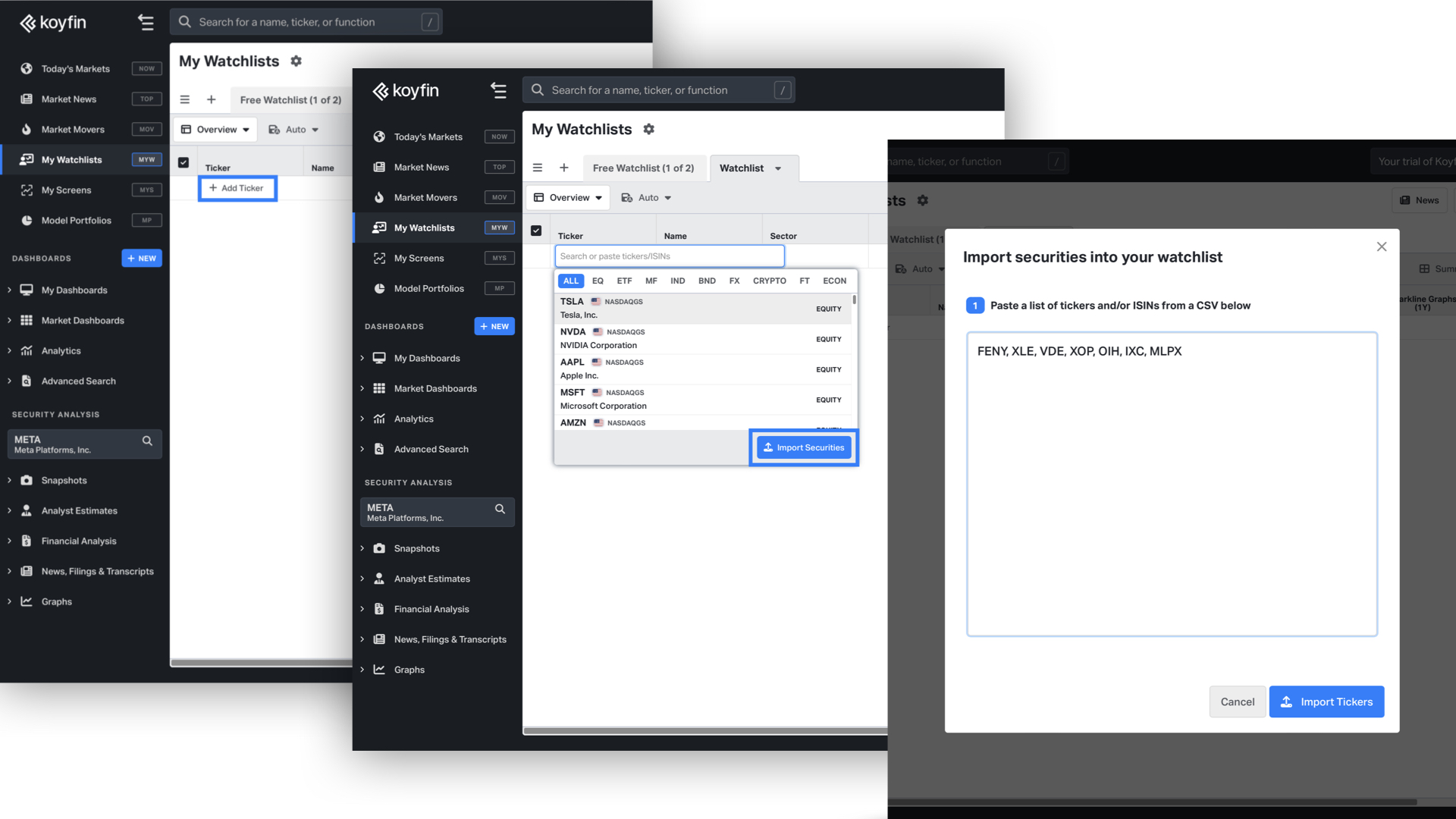
Step 4: Customize Columns. Hit the ‘Columns’ icon to add and remove columns from your watchlist table.
We have thousands of data points you can add to a watchlist, including fundamental data, price and returns data, analyst estimates, percentile ranks, security information, portfolio tools, and the ability to create your own formulas and labels.
Now your watchlist is ready, and you can use the rest of the Koyfin terminal to track and analyze these stocks.
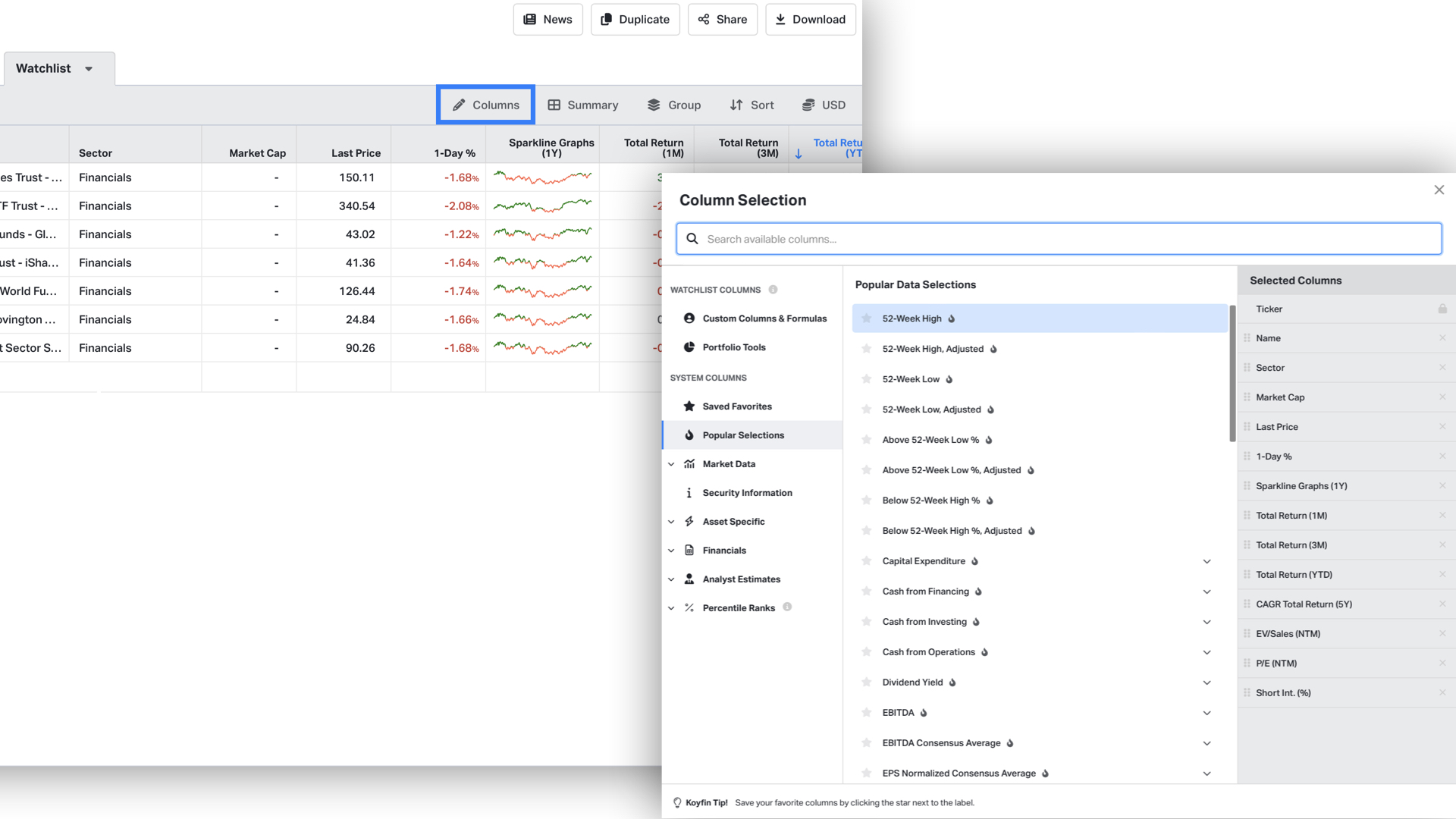
FAQ
-
What are "food stocks"?
“Food stocks” refer to the shares of companies that are involved in the production, distribution, or sale of food and beverages. There are key differences within this category:
Consumer Packaged Goods (CPG) Companies like PepsiCo and Coca Cola, which sell pre-packaged products.
Restaurant Businesses like Starbucks and Chipotle, which serve food directly to consumers.
These stocks represent different facets of the food industry.
-
Do these stocks pay dividends?
Not all food stocks pay dividends. A company’s willingness to pay dividends varies based on several factors. In this list, four of the nine selected companies pay a dividend; Greggs PLC, Starbucks, Wingstop, and Restaurant Brands International.
-
What is the difference between franchise and company-operated?
The difference between franchise and company-operated is that in a franchise model, individual franchisees buy the rights to operate a location or multiple locations using the brand and business model of the parent company. The franchisee typically pays an initial fee and ongoing royalties to the franchisor. In a company-operated model, the parent company owns and operates the locations directly, maintaining full control and retaining all profits. Company-operated stores bring in more revenue to the parent organization, but come with higher operating costs. Conversely, franchised stores bring in less revenue as they only pay fees to the parent, but because the operating costs are covered by the franchisee, the margins are greater for the parent.
-
Where can I find more food stocks?
In Koyfin, head to the Snapshots Overview page of a company in the food business that you like, and in the Key Data section, we list a number of their competitors.
-
Are there ETFs that track food stocks?
Yes, there are ETFs focused on food stocks that cover various parts of the food industry. Some top picks include:
KXI: iShares Global Consumer Staples ETF, which includes global food and beverage companies.
FTXG: First Trust Nasdaq Food & Beverage ETF, focusing on food and beverage companies listed on the Nasdaq.
EATZ: The Restaurant ETF, targeting restaurants and food-related businesses.
PEJ: Invesco Dynamic Leisure and Entertainment ETF, which includes food and beverage companies along with other leisure sectors.
XLY: Consumer Discretionary Select Sector SPDR Fund, broader in scope but still captures major food companies.
Editorial note
Our insights are derived solely from historical information and analyst predictions, employing an impartial approach. Please note that our articles do not serve as financial guidance.









